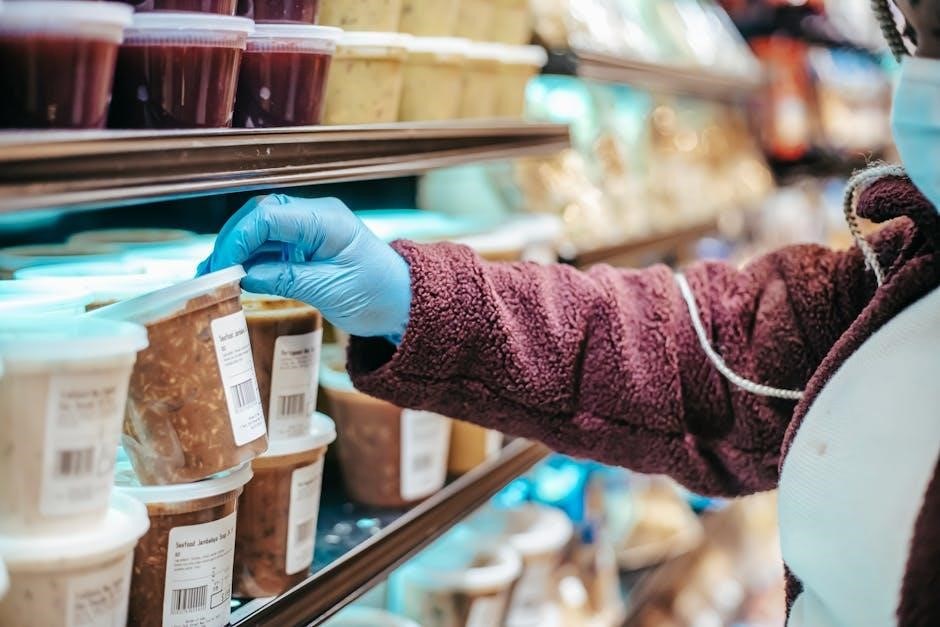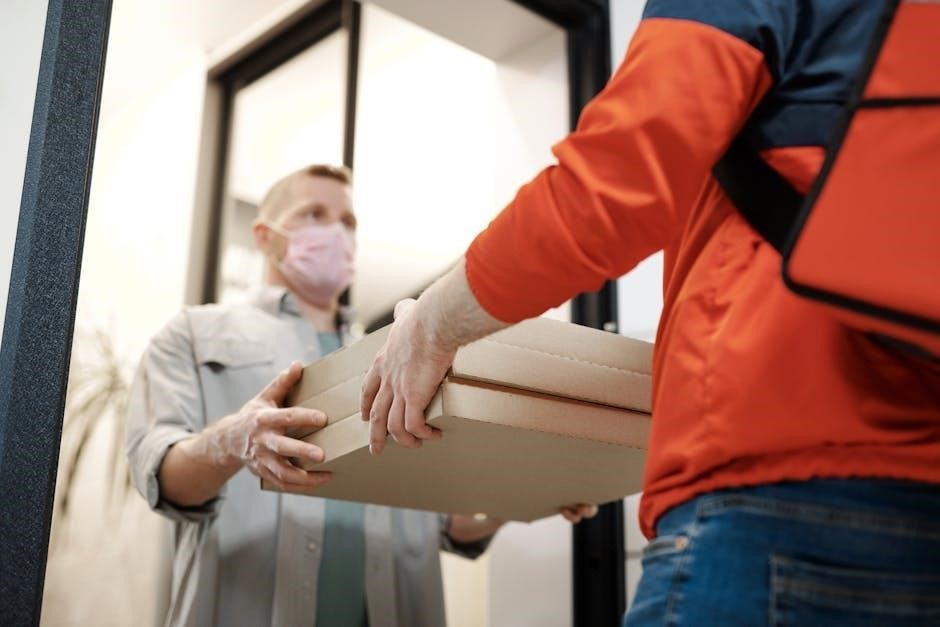Food Safety Level 2 focuses on preventing foodborne illnesses through proper hygiene‚ cleaning‚ and temperature control. It covers key practices and regulatory compliance‚ ensuring safe food handling.
1.1 What is Food Safety Level 2?
Food Safety Level 2 is a certification program designed to equip individuals with essential knowledge and skills to handle food safely. It focuses on preventing foodborne illnesses by addressing key areas such as personal hygiene‚ cleaning practices‚ and temperature control. This level is typically aimed at food handlers who are directly involved in food preparation and service. The training covers critical topics like understanding foodborne pathogens‚ proper food storage‚ and the importance of maintaining a clean working environment. By completing this level‚ individuals gain a deeper understanding of food safety principles and practices‚ enabling them to contribute to a safer food environment. It is a vital step for anyone working in the food industry‚ ensuring compliance with food safety regulations and promoting public health.
1.2 Importance of Food Safety Training
Food safety training is crucial for preventing foodborne illnesses and ensuring the well-being of consumers. It equips food handlers with the knowledge to identify risks and implement safe practices. Proper training reduces the likelihood of contamination‚ protecting both customers and businesses from legal and financial repercussions. It also fosters a culture of accountability‚ encouraging employees to adhere to hygiene and safety protocols. Additionally‚ food safety training ensures compliance with regulatory standards‚ maintaining trust and reputation in the food industry. By understanding the principles of food safety‚ individuals can contribute to a safer food environment‚ ultimately safeguarding public health and promoting consumer confidence.

Understanding Foodborne Illnesses
Foodborne illnesses occur when consuming contaminated food‚ often caused by bacteria‚ viruses‚ or toxins. They can lead to severe health issues‚ emphasizing the need for prevention through safe food handling practices.
2.1 Common Causes of Foodborne Illnesses
Foodborne illnesses are often caused by consuming contaminated food‚ with bacteria‚ viruses‚ and toxins being primary culprits. Common bacterial causes include E. coli‚ Salmonella‚ and Staphylococcus aureus. Viral contaminants‚ such as norovirus‚ also contribute significantly. Contamination can occur during food handling‚ preparation‚ or storage‚ especially when proper hygiene practices are neglected. Cross-contamination from raw to ready-to-eat foods is another major factor. Additionally‚ improper cooking temperatures and inadequate refrigeration allow harmful microorganisms to thrive. Food handlers with poor hygiene or who are already ill can directly transfer pathogens to food. Understanding these causes is crucial for implementing effective prevention strategies to safeguard public health and ensure food safety standards are met.
2.2 Symptoms and Risks
Foodborne illnesses often present with symptoms such as nausea‚ vomiting‚ diarrhea‚ and abdominal pain‚ typically appearing within hours to days after consumption. In severe cases‚ symptoms may include fever‚ dehydration‚ and even life-threatening complications. Vulnerable groups‚ such as the elderly‚ young children‚ and individuals with weakened immune systems‚ are at higher risk of severe outcomes. If left untreated‚ certain foodborne illnesses can lead to long-term health issues‚ such as kidney damage or neurological disorders. Understanding these symptoms and risks is essential for prompt medical intervention and highlights the importance of adhering to food safety practices to protect public health and prevent outbreaks.

Personal Hygiene in Food Handling

Personal hygiene is critical in food handling to prevent contamination. Proper handwashing‚ wearing protective clothing‚ and maintaining good health habits are essential to ensure food safety and quality.
3.1 Handwashing Techniques
Proper handwashing is a cornerstone of food safety. Hands should be washed frequently using warm water and soap for at least 20 seconds‚ paying attention to palms‚ backs‚ fingers‚ and wrists. Scrubbing under nails and between fingers is essential to remove dirt and microorganisms. Handwashing should occur before starting work‚ after using the restroom‚ and after touching raw ingredients or contaminated surfaces. Sanitizers can supplement handwashing but are not a replacement. The six stages of wet cleaning—prepare‚ main clean‚ rinse‚ disinfect‚ final rinse‚ and dry—ensure thorough hygiene. Using detergents and sanitizers correctly helps reduce bacteria to safe levels‚ preventing cross-contamination and ensuring food safety.

3.2 Protective Clothing and Gear
Protective clothing and gear are essential in food safety to prevent contamination. This includes wearing clean uniforms‚ such as chef coats and aprons‚ to cover clothing and skin. Hairnets or hats are required to prevent hair from falling into food‚ while gloves made from non-porous materials like latex or nitrile protect hands and prevent direct contact with food. Footwear should be slip-resistant and easy to clean to maintain hygiene in wet environments. These items act as barriers‚ reducing the risk of transferring bacteria to food. Proper use and maintenance of protective gear ensure a clean working environment‚ aligning with food safety standards and preventing cross-contamination risks during food preparation and handling.

Cleaning and Sanitation Practices
Cleaning and sanitation are crucial for removing contaminants and preventing foodborne illnesses. Detergents break down dirt‚ while sanitizers reduce bacteria to safe levels‚ ensuring a hygienic environment.
4.1 Effective Cleaning Procedures
Effective cleaning procedures involve six key stages: prepare‚ main clean‚ rinse‚ disinfect‚ final rinse‚ and dry. Preparation ensures surfaces are clear of debris. The main clean uses detergents to remove dirt and grease. Rinsing eliminates residual detergent. Disinfection reduces bacteria to safe levels‚ often using sanitizers. A final rinse removes any disinfectant residue‚ and drying prevents moisture buildup‚ which can harbor bacteria. These steps ensure thorough removal of contaminants‚ preventing foodborne illnesses. Proper cleaning is essential for maintaining hygiene and safety in food handling environments‚ aligning with food safety regulations and best practices.
4.2 Role of Detergents and Sanitizers
Detergents and sanitizers play crucial roles in food safety. Detergents are used to remove dirt‚ grease‚ and food residue‚ ensuring surfaces are clean before sanitization. Sanitizers reduce bacteria to a safe level‚ preventing contamination. Together‚ they maintain hygiene standards‚ essential for preventing foodborne illnesses. Proper use of these agents ensures food handling areas remain clean and safe‚ aligning with food safety regulations and best practices.

Temperature Control in Food Safety
Temperature control is critical in food safety to prevent bacterial growth. Monitoring and recording temperatures ensures food is stored‚ cooked‚ and reheated safely‚ reducing foodborne illness risks.
5.1 Safe Temperature Ranges
Safe temperature ranges are essential to prevent bacterial growth and ensure food safety. For refrigeration‚ food should be stored at 1°C to 5°C to slow bacterial multiplication. Frozen foods must be kept at -18°C or below to halt bacterial activity. Cooked foods should be maintained at 63°C to 75°C to prevent contamination. When reheating‚ food must reach 75°C throughout to kill harmful bacteria. These temperature ranges are critical for maintaining food quality and preventing foodborne illnesses. Proper temperature control is a cornerstone of food safety practices‚ ensuring that food remains safe for consumption and reducing the risk of contamination. Adhering to these guidelines helps protect consumers from potential health risks associated with improperly stored or cooked food.
5;2 Monitoring and Recording Temperatures
Monitoring and recording temperatures are critical steps in maintaining food safety. Food probes should be used to check temperatures accurately‚ ensuring foods are within safe ranges. Temperatures must be recorded at regular intervals‚ especially during delivery‚ storage‚ and cooking. This documentation helps verify compliance with food safety standards and provides traceability in case of issues. Monitoring prevents bacterial growth by ensuring foods are stored below 5°C or kept hot above 63°C. Records also aid in identifying potential temperature abuses. Accurate and consistent temperature checks are essential for protecting consumer health and adhering to legal requirements. Regular training ensures staff understand the importance of temperature control and accurate record-keeping.
Preventing Cross-Contamination
Preventing cross-contamination involves separating raw and ready-to-eat foods‚ using dedicated utensils‚ and ensuring proper handwashing. Regular cleaning and sanitizing of surfaces and equipment are essential to reduce contamination risks.

6.1 Direct vs. Indirect Contamination
Direct contamination occurs when harmful bacteria or substances come into contact with food directly‚ such as through raw meat or unwashed hands. Indirect contamination happens when bacteria are transferred via intermediate sources like utensils‚ cutting boards‚ or clothing. Direct contamination is often more immediate and visible‚ while indirect contamination can be harder to detect but equally dangerous. For example‚ using a knife to cut raw chicken and then slicing vegetables without proper cleaning leads to indirect contamination. Understanding the difference is crucial for implementing effective prevention strategies‚ such as proper handwashing‚ using separate utensils for raw and cooked foods‚ and regularly sanitizing surfaces and equipment. This helps minimize the risk of foodborne illnesses and ensures safer food handling practices.
6.2 Strategies to Prevent Contamination
To prevent contamination‚ it’s essential to implement effective strategies. Separate raw and ready-to-eat foods to avoid cross-contamination. Use disposable gloves when handling raw ingredients and wash hands frequently. Ensure all utensils and equipment are cleaned and sanitized regularly. Store food at appropriate temperatures to inhibit bacterial growth. Label and date stored items to maintain rotation and reduce spoilage. Regularly inspect food and discard any items showing signs of spoilage. Train staff on proper food handling and hygiene practices. Use food-safe cleaning products and follow proper dilution guidelines. By adopting these practices‚ contamination risks can be significantly minimized‚ ensuring a safer food environment for consumers.
Safe Food Handling and Preparation
Safe food handling involves proper receiving‚ storing‚ and preparing techniques. Ensure food is stored at correct temperatures and cooked thoroughly to prevent contamination and foodborne illnesses.
7.1 Receiving and Storing Food

Proper food receiving and storage are critical to maintaining safety and quality. When receiving food‚ inspect for signs of spoilage‚ damage‚ or contamination. Ensure all deliveries are at safe temperatures‚ with perishables stored immediately. Store food in clean‚ pest-free areas‚ keeping raw and ready-to-eat foods separate to prevent cross-contamination. Label and date all items‚ and follow the “first in‚ first out” rule to avoid spoilage. Use appropriate storage containers and maintain correct temperatures: below 5°C for refrigerated items and below -18°C for frozen foods. Regularly monitor storage conditions to ensure compliance with food safety standards and prevent bacterial growth. Proper storage practices help preserve food quality and reduce risks of foodborne illnesses. Always follow local food safety regulations for specific storage requirements.
7.2 Cooking and Reheating Safely
Cooking and reheating food safely is essential to prevent foodborne illnesses. Always cook food to the recommended internal temperature: at least 75°C (167°F) for high-risk foods like poultry and meat. Use a food thermometer to ensure accuracy. When reheating‚ food must reach a minimum of 82°C (180°F) throughout to kill harmful bacteria. Avoid reheating food multiple times‚ as this can create ideal conditions for bacterial growth. Prevent cross-contamination by using separate utensils and surfaces for raw and cooked foods. Never defrost food at room temperature; instead‚ thaw in the refrigerator‚ in cold water‚ or in the microwave. Proper cooking and reheating practices ensure food is safe to eat and maintain its quality. Always follow food safety guidelines to reduce the risk of foodborne illnesses. Regular training and awareness are key to safe food handling.

Food Safety Regulations and Standards
Food safety regulations ensure compliance with legal requirements‚ protecting consumer health. Standards like HACCP guide practices‚ maintaining safety and quality in food production and service environments.
8.1 Overview of HACCP
HACCP (Hazard Analysis Critical Control Point) is a systematic approach to food safety‚ identifying and controlling biological‚ chemical‚ and physical hazards. It ensures food is safe for consumption by monitoring critical points in production‚ processing‚ and distribution. The seven principles of HACCP include hazard analysis‚ determining critical control points‚ setting safety limits‚ monitoring controls‚ taking corrective actions‚ verifying effectiveness‚ and maintaining records. This framework is widely recognized and implemented in the food industry to prevent foodborne illnesses and comply with regulatory standards. By focusing on prevention rather than inspection‚ HACCP promotes a proactive approach to food safety‚ reducing risks and ensuring consumer health.
8.2 Compliance with Food Safety Laws
Compliance with food safety laws is essential for maintaining public health and preventing foodborne illnesses. These laws establish standards for food handling‚ preparation‚ and storage to ensure safety throughout the supply chain. Key areas include proper hygiene practices‚ temperature control‚ and record-keeping. Food businesses must adhere to regulations such as HACCP and local food safety codes. Non-compliance can result in legal penalties‚ fines‚ and reputational damage. Regular inspections and audits help verify adherence to these laws. Understanding and following food safety legislation is crucial for all food handlers to protect consumers and uphold industry standards. Compliance ensures a safe and reliable food supply‚ benefiting both businesses and the public.
Exam Preparation and Practice Tests
Exam preparation involves using practice tests to assess knowledge and identify weak areas. Studying topics like foodborne illnesses and hygiene ensures comprehensive understanding. Utilizing resources like Food Safety Level 2 answer PDFs provides valuable exam tips and familiarizes candidates with question formats‚ boosting confidence and readiness for the actual test.
9.1 Tips for Passing the Food Safety Exam
To excel in the Food Safety Level 2 exam‚ thorough preparation is essential. Start by reviewing practice tests and answer PDFs to familiarize yourself with question formats. Focus on understanding key topics such as foodborne illnesses‚ hygiene practices‚ and temperature control. Allocate time to study each section‚ ensuring a strong grasp of concepts like cleaning procedures and cross-contamination prevention. Utilize online resources to reinforce learning and identify areas needing improvement. During the exam‚ manage your time effectively‚ answering all questions and reviewing them if possible. Stay calm and read each question carefully to avoid mistakes. By combining consistent study habits with strategic exam techniques‚ you can confidently achieve success in the Food Safety Level 2 certification.
9.2 Utilizing Practice Tests Effectively
Practice tests are a valuable tool for preparing for the Food Safety Level 2 exam. They help identify knowledge gaps and improve understanding of key concepts. Start by completing full-length practice tests under timed conditions to simulate exam pressure. Review the answers thoroughly‚ focusing on areas where mistakes were made. Use official PDF resources to ensure the questions align with the exam format. Pay attention to recurring topics‚ such as foodborne illnesses‚ cleaning procedures‚ and temperature control. Analyze the reasoning behind correct answers to reinforce learning. Regularly retaking practice tests builds confidence and familiarity with the material. By systematically addressing weaknesses‚ you can approach the exam with assurance and achieve a high score.
Common Food Safety Myths and Facts
Myth: Food is safe if it looks‚ smells‚ or tastes okay. Fact: Bacteria like E. coli and Salmonella can’t be detected by sight‚ smell‚ or taste. Always follow safety guidelines.
10.1 Debunking Myths
A common myth is that food is safe if it looks‚ smells‚ or tastes fine. However‚ harmful bacteria like E. coli and Salmonella can’t be detected through sight‚ smell‚ or taste. Another myth is that all cleaning methods are equally effective. In reality‚ proper cleaning involves six stages: prepare‚ clean‚ rinse‚ disinfect‚ final rinse‚ and dry. Detergents and sanitizers serve different roles—detergents remove dirt and grease‚ while sanitizers reduce bacteria to safe levels. Understanding these distinctions is crucial for maintaining food safety standards. Misconceptions can lead to unsafe practices‚ so it’s essential to rely on proven methods and guidelines to ensure consumer health and safety.
10.2 Separating Fact from Fiction
Separating fact from fiction in food safety is crucial for maintaining safe practices. A common misconception is that foodborne illnesses are always caused by direct contamination. However‚ indirect contamination‚ such as transferring bacteria via utensils or clothing‚ is equally dangerous. Another myth is that food safety is solely about personal hygiene‚ but proper cleaning‚ storage‚ and temperature control are equally vital. For instance‚ detergents and sanitizers are often confused‚ but detergents remove dirt‚ while sanitizers reduce bacteria to safe levels. Understanding these distinctions ensures effective food handling. Reliable guidelines and training‚ like those in Food Safety Level 2‚ help clarify these misconceptions‚ promoting a safer food environment for everyone.